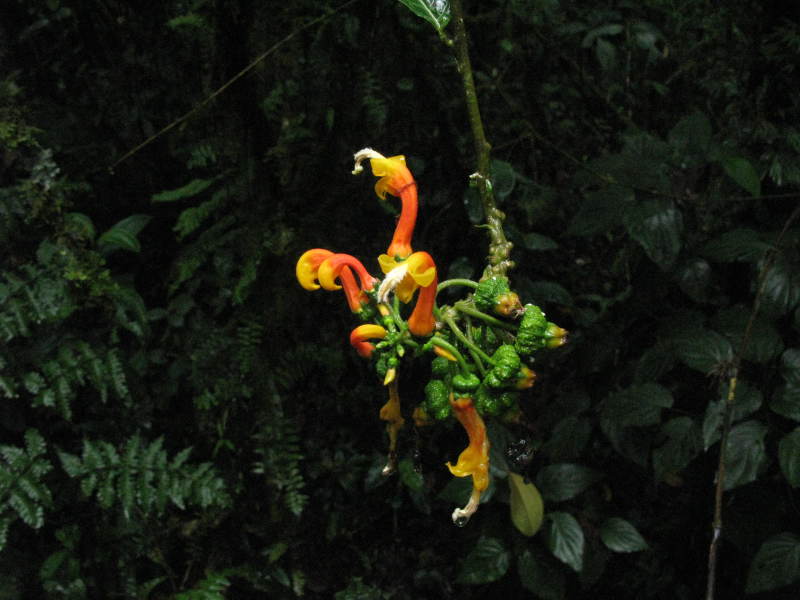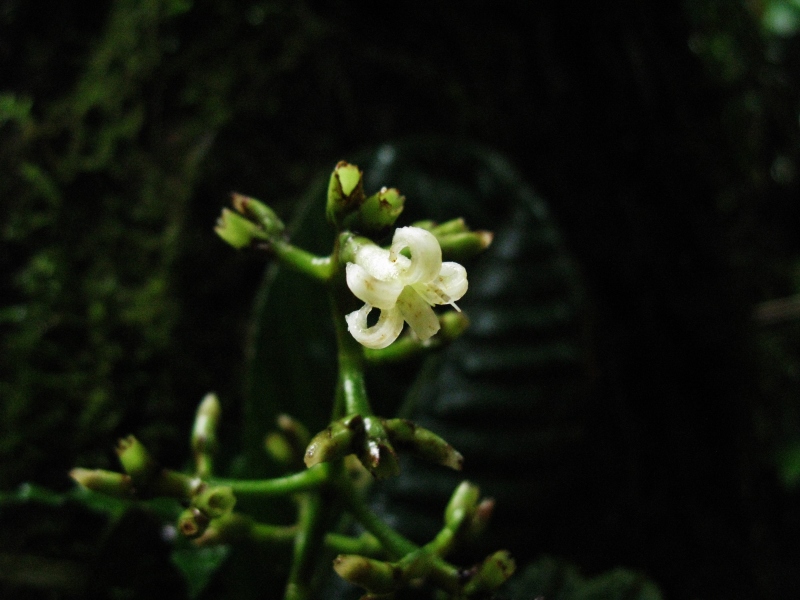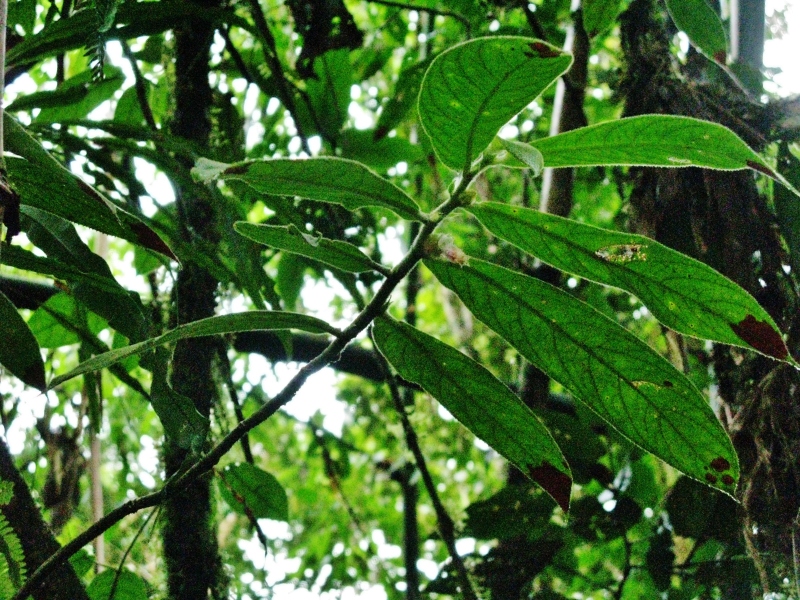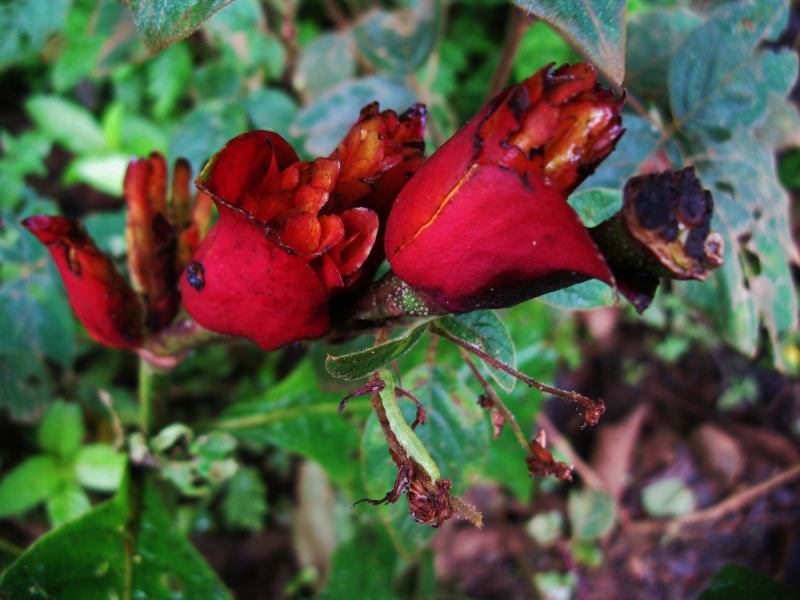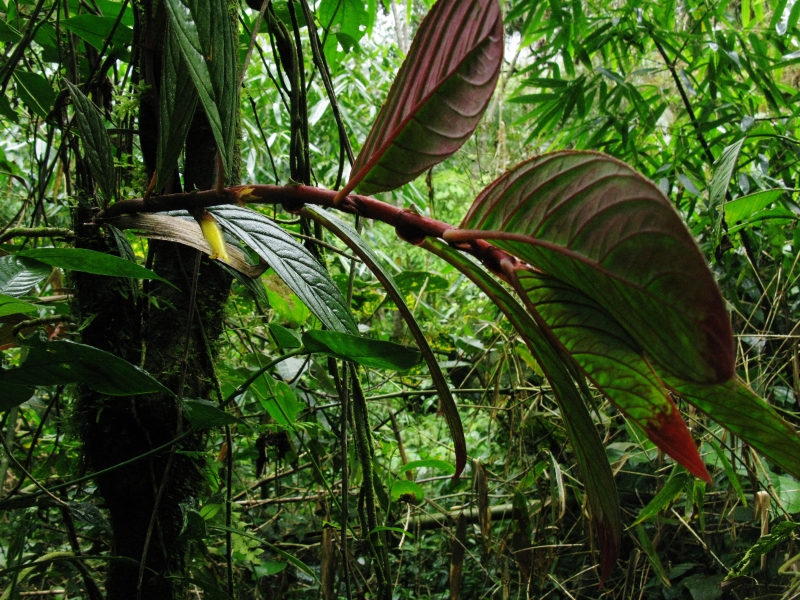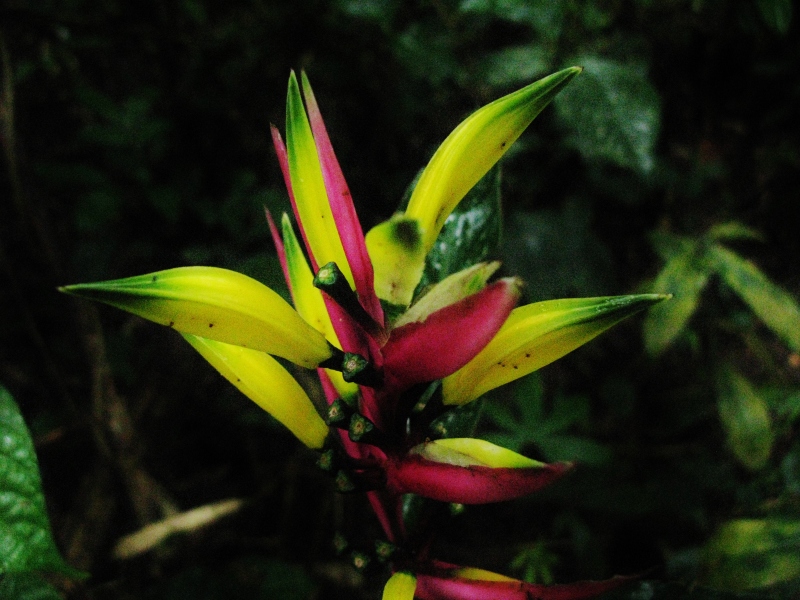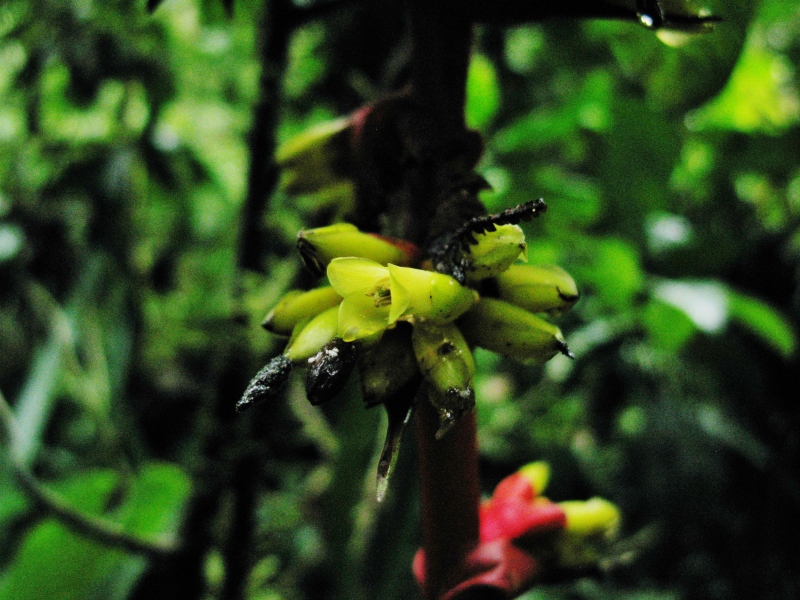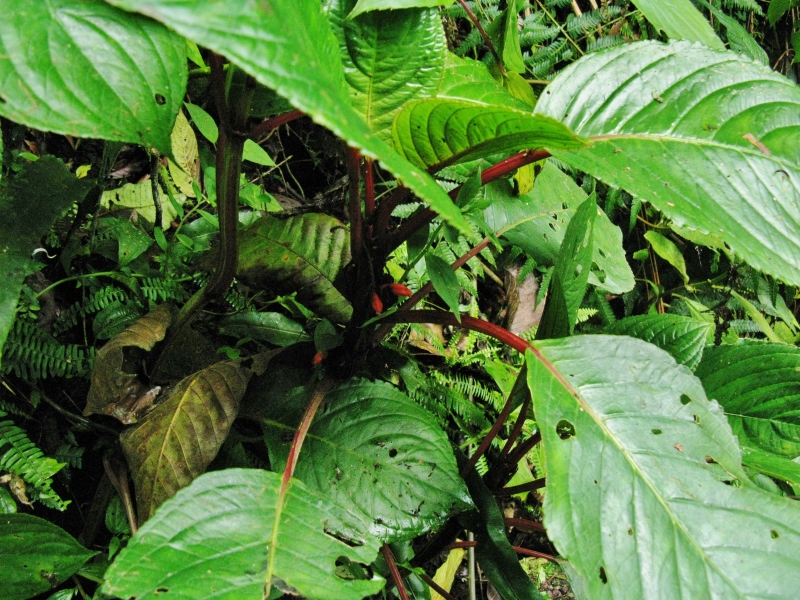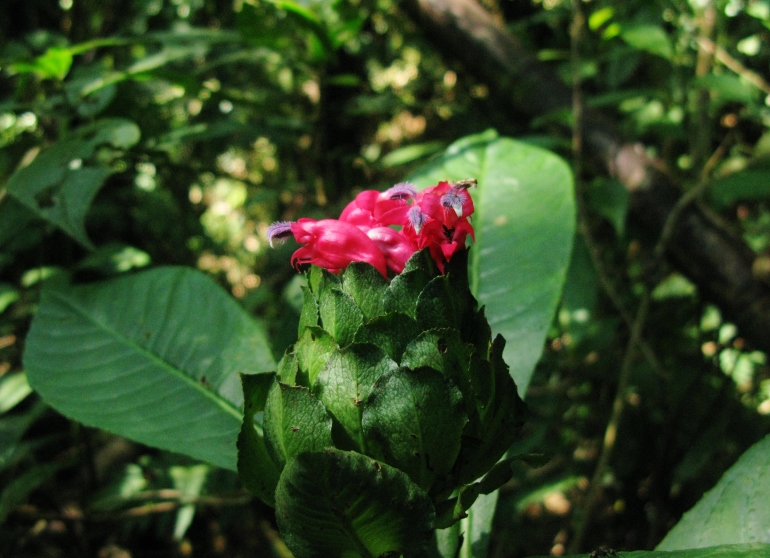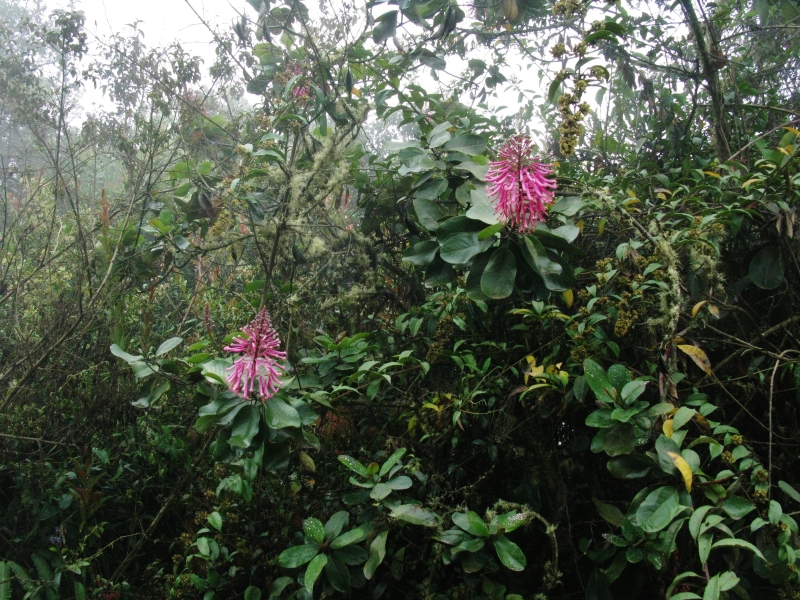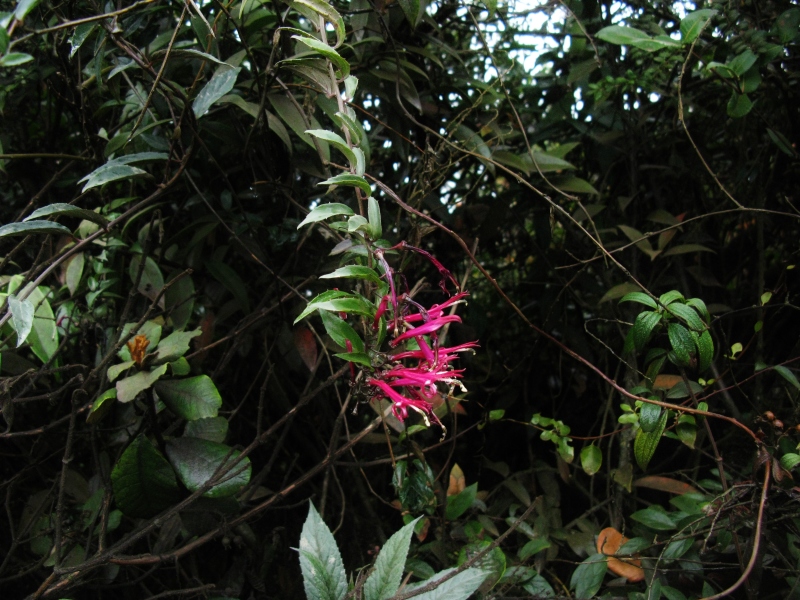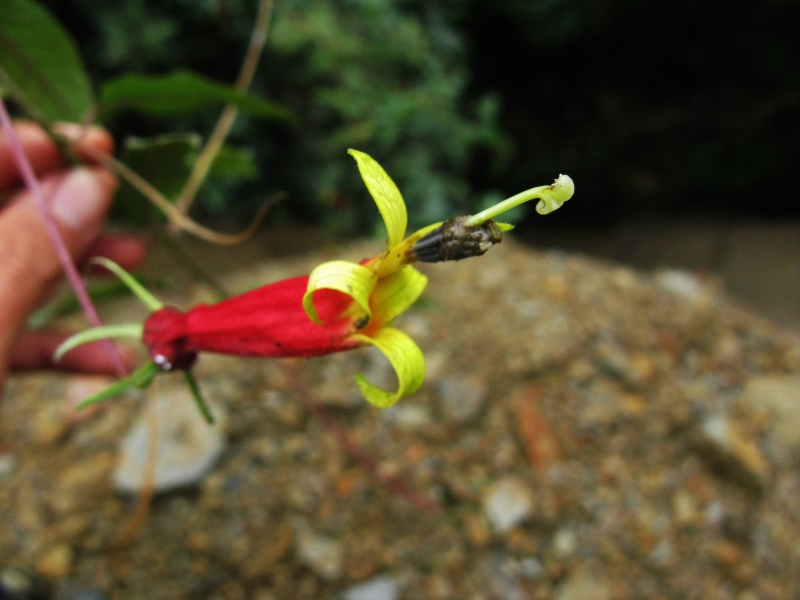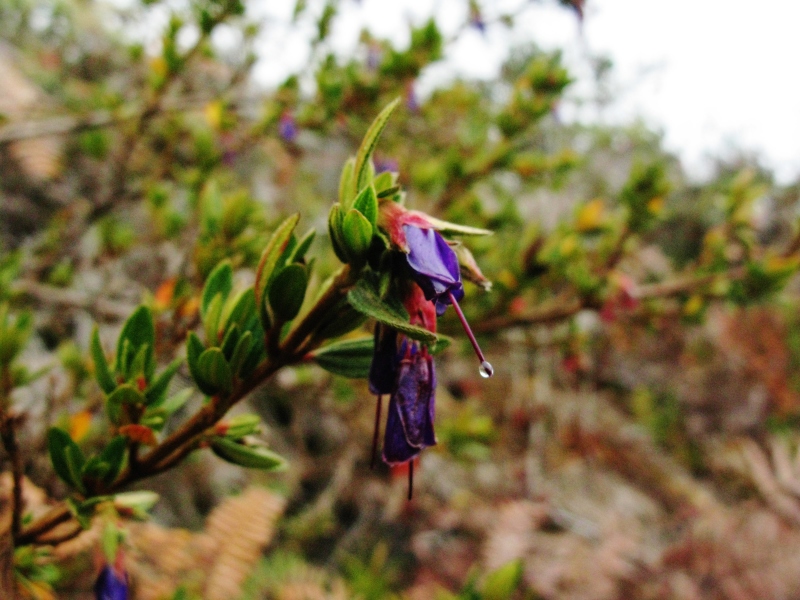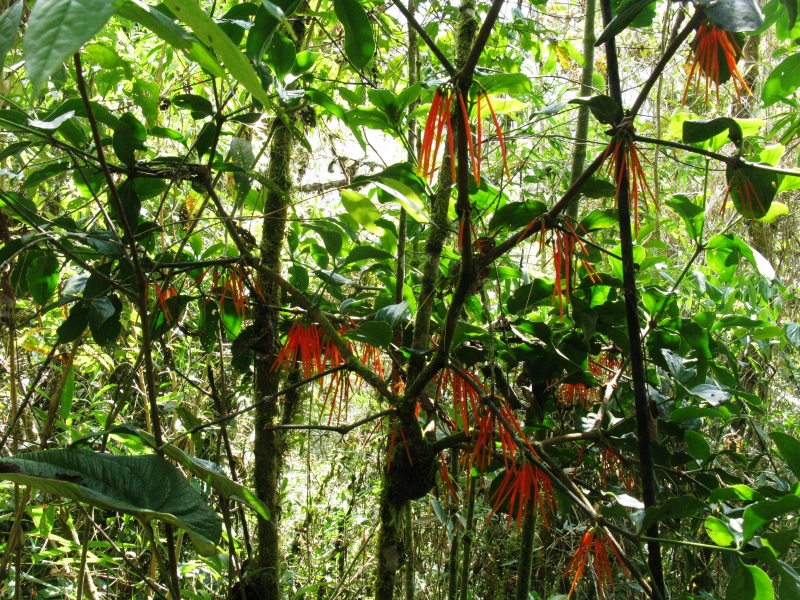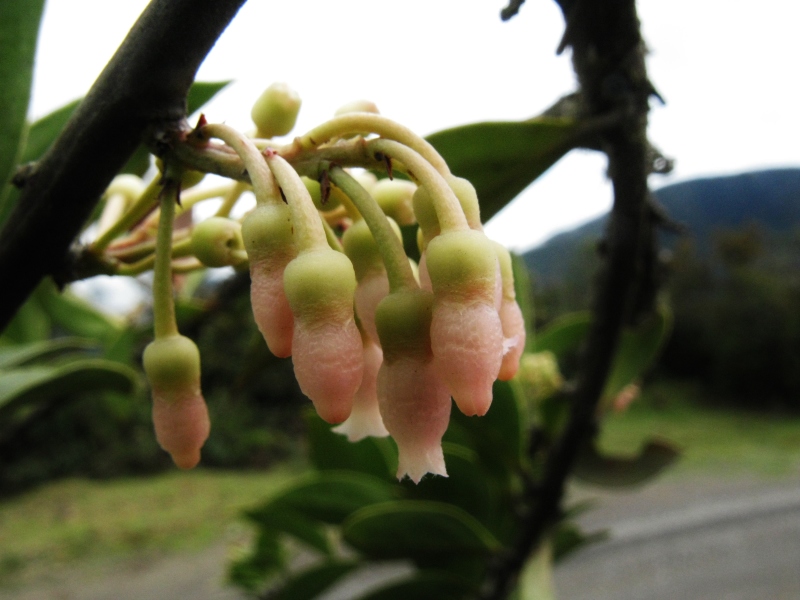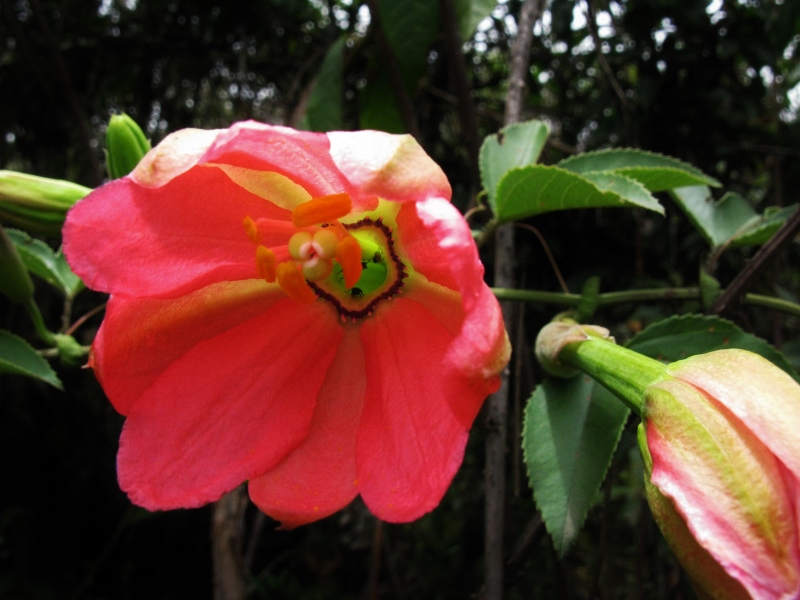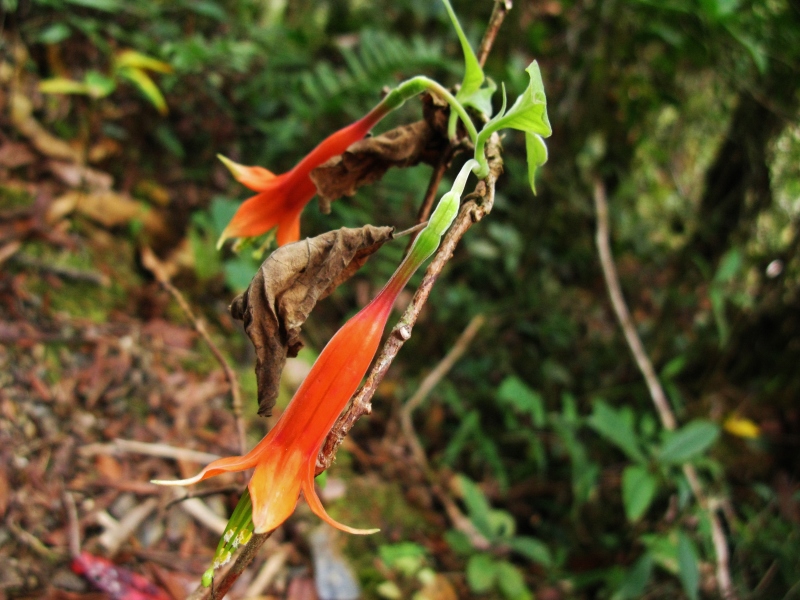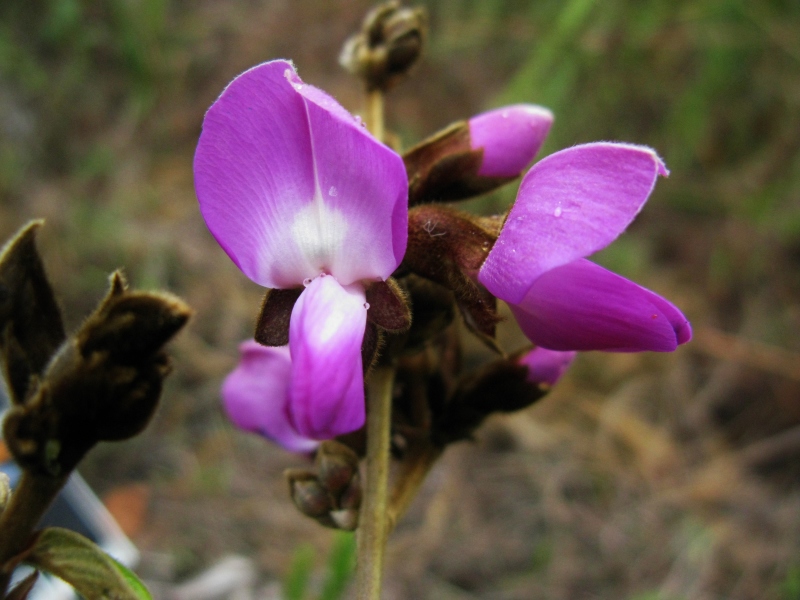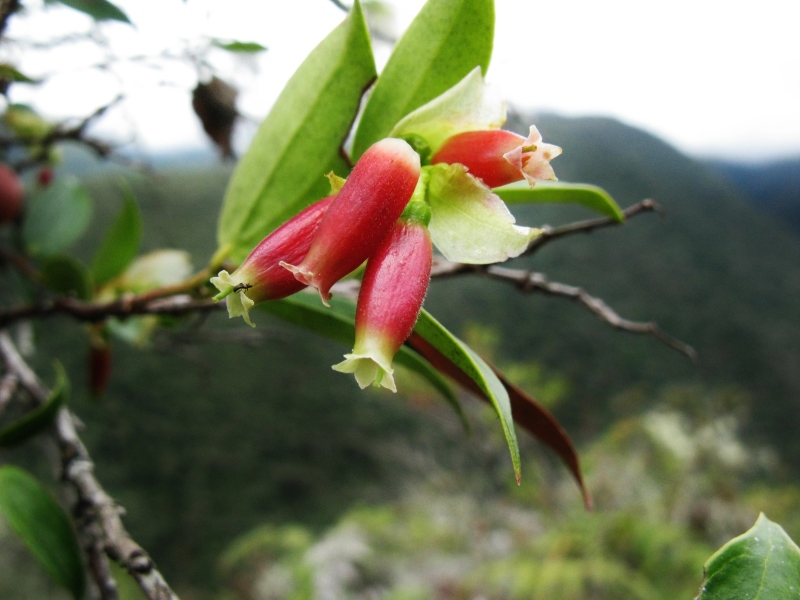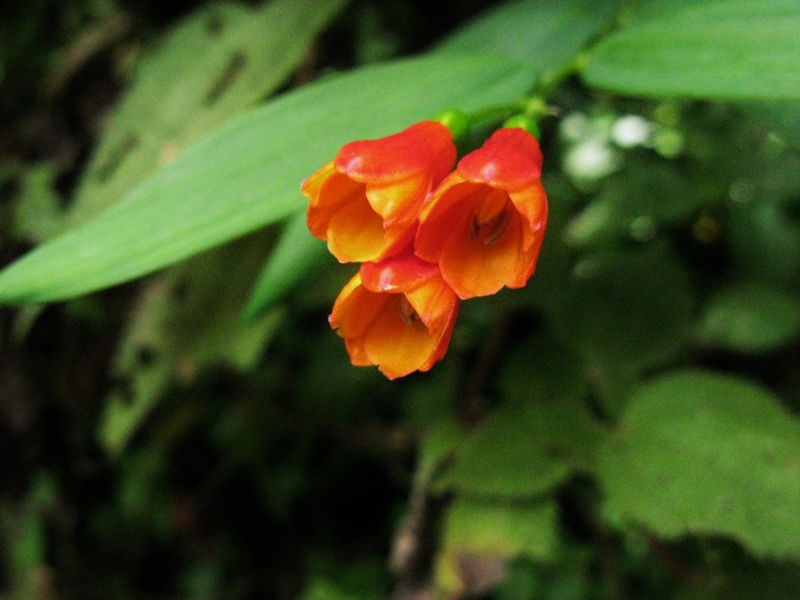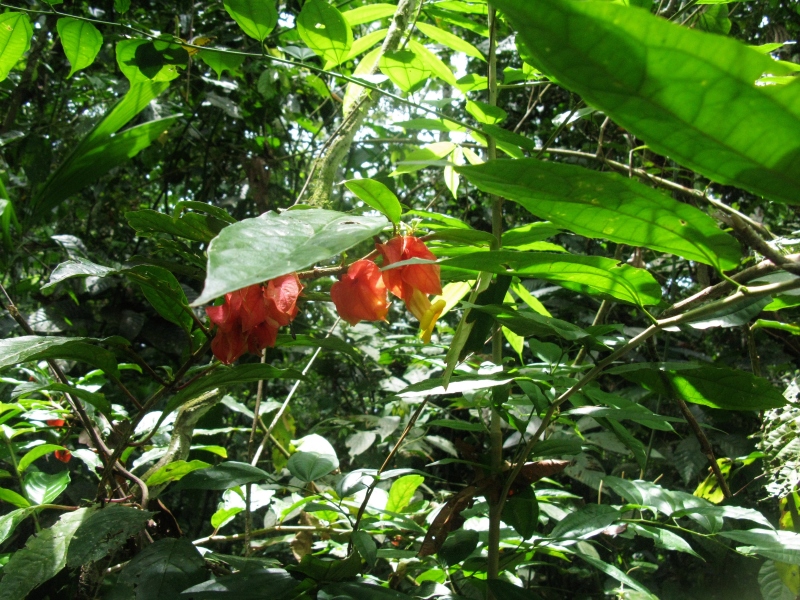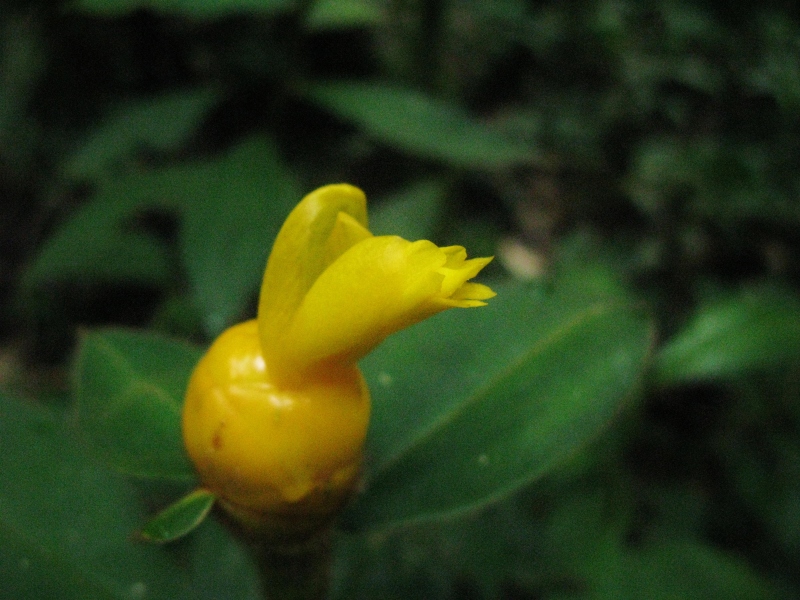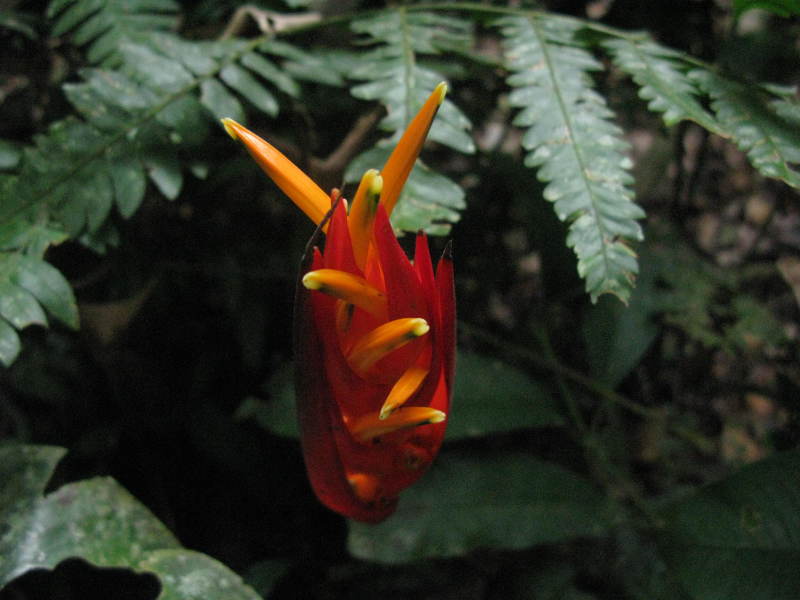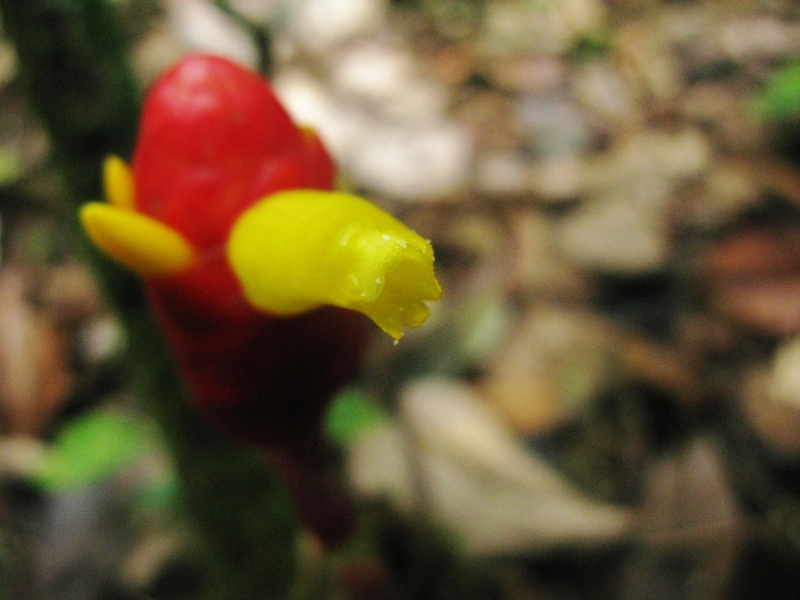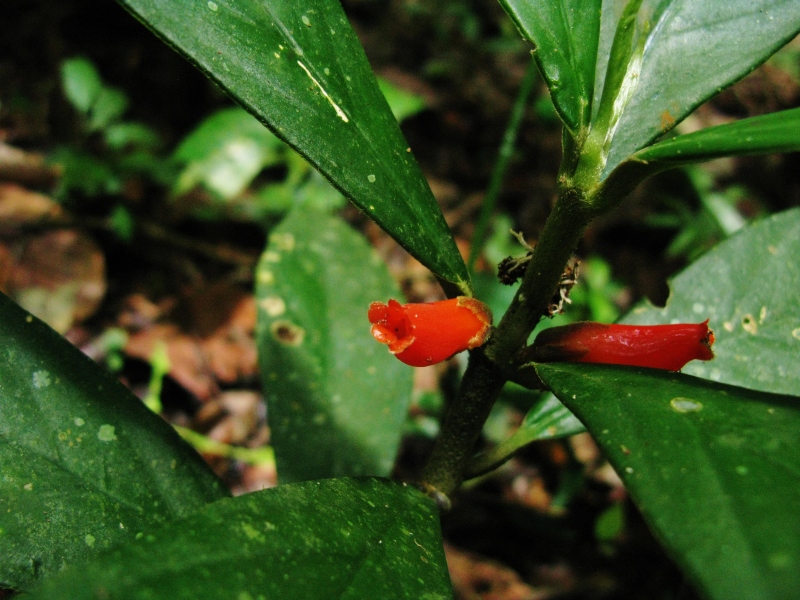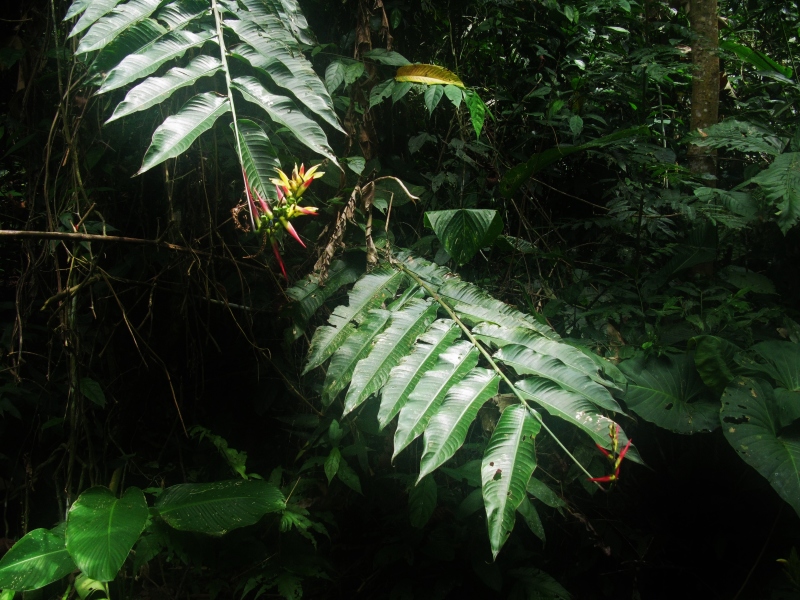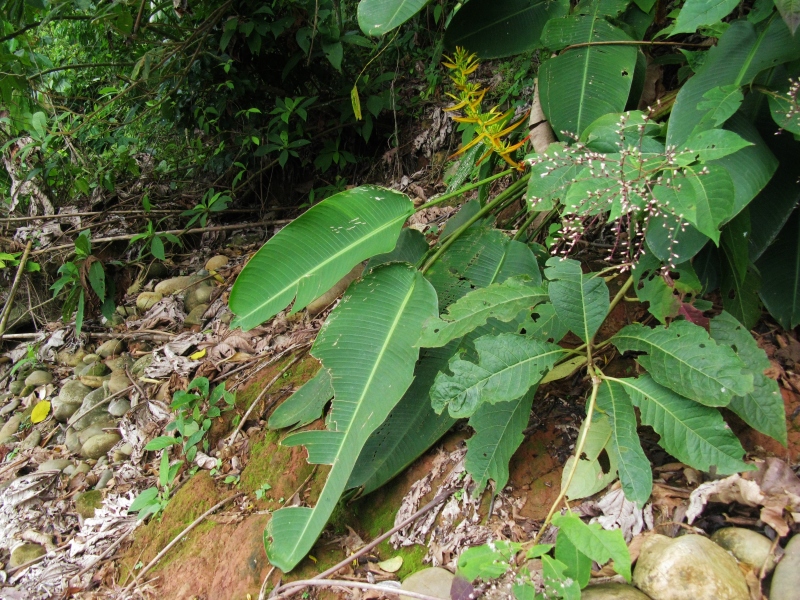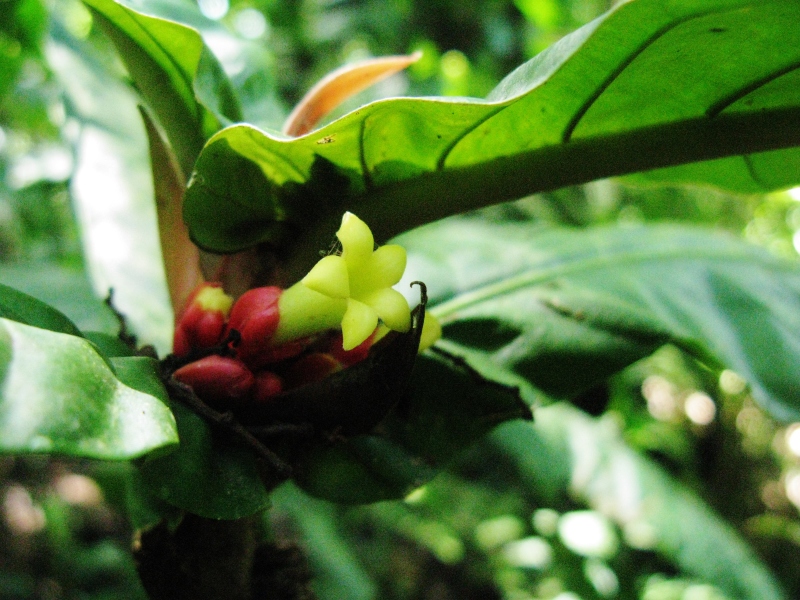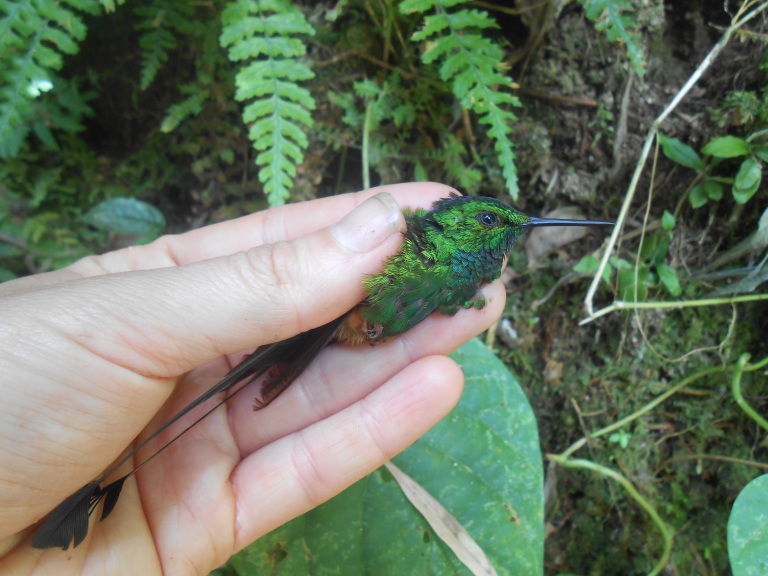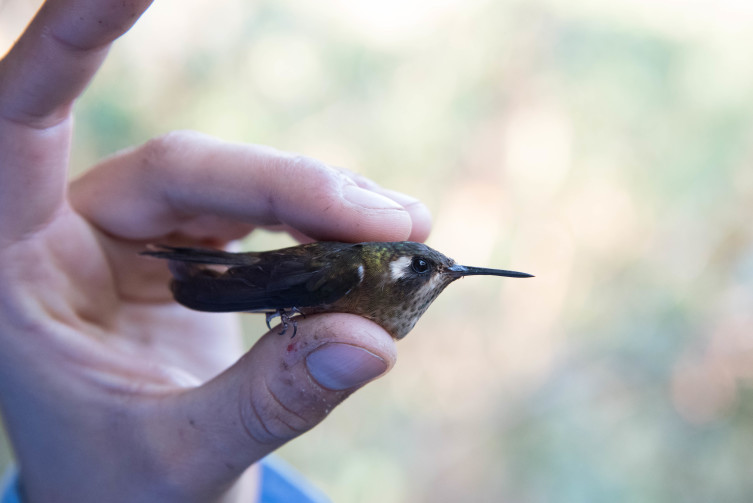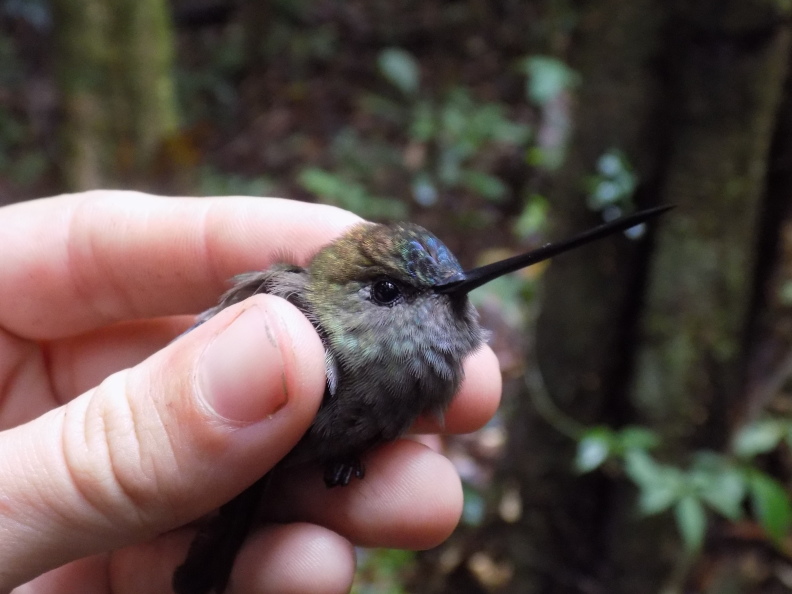Abstract Abstract
Background
This study establishes an altiudinal gradient, spanning from the highland Andes (2400 m) to lowland Amazon, as a productive region for the study of bird pollination in Southeastern Peru. The 'Manú Gradient' has a rich history of ornithological research, the published data and resources from which lay the groundwork for analyses of plant-bird interactions. In this preliminary expedition we documented 44 plants exhibting aspects of the bird pollination syndrome, and made field observations of hummingbird visits at three sites spanning the Manú Gradient: 2800 m (Wayqecha), 1400 m (San Pedro), and 400 m (Pantiacolla). Some of the documented plant taxa are underrepresented in the bird pollination literature and could be promising avenues for future analyses of their pollination biology. The Manú Gradient is currently the focus of a concerted, international effort to describe and study the birds in the region; we propose that this region of Southeastern Peru is a productive and perhaps underestimated system to gain insight into the ecology and evolution of bird pollination.
New information
Observations were made on 11, 19, and 14 putatively bird pollinated plant species found at the high-, mid- and low-elevation sites along the gradient, respectively. Hummingbirds visited 18 of these plant species, with some plant species being visited by multiple hummingbird species or the same hummingbird species on differing occasions. Morphometric data is presented for putatively bird-pollinated plants, along with bill measurements from hummingbirds captured at each of three sites. Voucher specimens from this study are deposited in the herbaria of the Universidad Nacional de Agraria de La Molina (MOL), Peru and the University of British Columbia (UBC), Canada. The specimens collected represent a ‘snapshot’ of the diversity of bird-pollinated flora as observed over 10 day sampling windows (per site) during the breeding season for hummingbirds of Manú .
Keywords: Hummingbirds, elevational gradient, co-evolution, ornithophily, pollination ecology, Andes, Amazon, neotropics
Introduction
Manú National Park is a UNESCO Biosphere Reserve nested within the most biodiverse region in the world: the tropical Andes (Myers et al. 2000). Manú Park, and its surrounding forests encompass a remarkable elevational gradient (hereafter the 'Manú Gradient') of over 3000 m, reaching from the lowland Amazon rainforest to the Puna grasslands of the high Andes. The Manú Gradient has a rich history of ornithological research (discussed in Walker et al. 2006), and over the last decade the Manú Gradient has been the focus of numerous ornithological studies as part of the Manú Bird Project (e.g. Merkord 2010, Jankowski et al. 2012a, Jankowski et al. 2012b, Londoño et al. 2014, Londoño et al. 2016, Dehling et al. 2014, Munoz 2016). Along the gradient, tree composition and forest structure have also been described (e.g. Jankowski et al. 2012b, Malhi et al. 2010, Hillyer and Silman 2010). The wide interest in the avian community of Manú make it an ideal system for studying hummingbird pollination: population structure, range limits, and locations of uncommon and understudied hummingbirds are described and published. For example, focused studies of the high elevation Shining Sunbeam (Aglaeactis cupripennis) have demonstrated the effectiveness of the Manú Gradient as a study system for bird pollination (Hazlehurst et al. 2016, Hazlehurst and Karubian 2016). Therefore, the objectives of this study were to, 1) document the occurrence of putatively bird pollinated plants with voucher specimens along the Manú Gradient, 2) describe the occurrence and diversity of hummingbirds using mist-net surveys, and 3) record hummingbird visitations to flowering plants.
Materials and Methods
Site Selection
We surveyed three field sites spanning an altitudinal gradient of 2400 m (400 m to 2800 m) in the southeastern Andes (Table 5): La Estación Biológica Wayqecha (Paucartambo Province, Cuzco Region, 2800 m), San Pedro (Paucartambo Province, Cuzco Region, 1400 m), and Pantiacolla (Manú Province, Madre de Dios Region, 400 m). This area is one of the most biologically rich regions in the world with an estimated species pool of nearly 1100 birds (Walker et al. 2006). To our knowledge, a comprehensive survey of the vascular plants of the region does not exist, although an increasing number of plant identification resources for this region are being made available by the Field Museum of Natural History (http://fieldguides.fieldmuseum.org). Wayqecha is characterized as high elevation cloud forest, with a mosaic of mature forest and areas with shorter trees and woody shrubs that transitions into puna grassland above treeline. San Pedro is predominately mid-montane humid rainforest, but also includes the lower extent of the montane cloud forest. Pantiacolla is situated at the interface between the Andean foothills and the lowland Amazon. Detailed environmental characteristics for these sites have been summarized in Malhi et al. (2016). Sampling was carried out between September 4, 2016 and October 13, 2016, falling within the avian montane breeding season. A distinct rainy season occurs from November through April and a dry season from May through August. Annual precipitation for higher elevations (2700-3000 m) ranges from 1700-2000 mm (Girardin et al. 2010) and is generally >2000 mm for lowland (100-400 m elevation) sites (Rapp and Silman 2012). Time constraints afforded less than two weeks (10.3 ± 2.1 days) for botanical and avian sampling at each site.
Table 5.
Summary information and site descriptions for three sampling points along the Manú Gradient.
| Site (Latitude, Longitude) | Period Collected and Netted | Altitudinal Range Sampled (m asl) | Number of Plants Species Collected | Number of Hummingbirds Netted | Number of Hummingbird Species Netted | Number of Bird Visits Recorded | General Site Description |
| San Pedro (-13.055387, -71.546832) |
4-ix-2016 to 16-ix-2016 | 1149 - 1547 | 19 | 76 | 14 | 7 | Montane cloud forest, Cecropia readily found in disturbed habitats. Dominant palm is Wettinia and canopy is generally composed of Clusiaceae, Rubiaceae, Melastomataceae and Lauraceae (Weng et al. 2004). |
| Wayqecha (-13.1752615, -71.5884099) |
20-ix-2016 to 03-x-2016 | 2625 - 2979 | 11 | 65 | 15 | 10 | Highland cloud forest and puna grassland of mainly Asteraceae and Poaceae. Oreocalis grandiflora is a noteable and abundant tree species. Araliaceae, Cunoniaceae,Chloranthaceae, Myrsinaceae, Sabiaceae, and Symplocaceae are readily found (Weng et al. 2004). |
| Pantiacolla (-12.656544, -71.231862) |
07-x-2016 to 13-x-2016 | 391 - 428 | 14 | 31 | 9 | 8 | Lowland rainforest, includes both seasonally flooded and terra firme forests. Canopy dominated by Fabaceae, Malvaceae, Moraceae and Annonaceae (Weng et al. 2004, Weng et al. 2004) |
Data Collection
Pre-cut singletrack trails were used to access sampling areas away from the Manú Road (main access road that runs along the southeastern border of Manú National Park). We sampled hummingbirds using standard (12 x 3 m, 34 mm mesh) mist-nets along trail systems only. Mist-netting sites were sampled during the primary breeding season (August–November) for two consecutive days from approximately 0600–1200 hrs during suitable weather conditions (i.e., no periods of extended heavy rain, high winds, or other situations that could compromise researcher or bird safety). Each site consisted of an array of ten to fifteen nets placed in forested and open habitat and spaced at intervals of 25-50 m. Ten sites were sampled at Wayqecha and San Pedro, and 8 sites were sampled at Pantiacolla. Hummingbird bill length was measured from the bill tip to the nares. Bill width was measured from the anterior edge of the nares. All captured hummingbirds were marked by cutting the terminal 1-2 cm of one rectrix to avoid resampling of individuals.
Both trails and the Manú Road were used to opportunistically collect plants. Plants were considered putatively bird pollinated if they met criteria adhering to typical bird pollination ‘syndromes’; namely, dilute nectar and long tubular flowers (Fenster et al. 2004), though we acknowledge the limitations of surveying by these critera (Ollerton et al. 2009). Plants of interest were photographed, their location marked using a hand-held Garmin 64s global positioning system, and a description of the immediate habitat recorded. We then measured nectar concentration of mature flowers (Sper Scientific no. 66214-988), recorded corolla dimensions and colour (by visual inspection), and processed each plant using standard herbarium techniques Bridson and Forman 2000) (SERFOR collection permit no. 343-2016). All dried and pressed specimens are deposited at the herbaria of the Universidad Nacional Agraria La Molina (MOL), Peru and the University of British Columbia (UBC), Canada (SERFOR export permit no. 09125-2017).
Results
We identified 44 putatively bird pollinated plants of interest belonging to 16 families (Table 1, Figs 1, 2, 3, 4, 5). Corolla length and width of sampled plants ranged from 8-120 mm (x̅ = 39.7 ± 27.4, n = 42) and 1-60 mm (x̅ = 11.4 ± 12.2), respectively. We measured nectar concentration for 11 of these species. In each case, nectar concentrations fell within a typical bird pollination syndrome (Stiles 1978, Fenster et al. 2004), ranging from 12-25.5% (Table 1). Corolla colour and immediate habitat characteristics were recorded for each plant (Table 1, see also Table 5).
Table 1.
Putatively bird pollinated plants along the Manú Gradient.
| Plant Genus | Specific epithet | Family | Collection number(s) for plant specimens deposited in the herbaria of MOL and UBC | Corolla length (mm) | Corolla width (mm) | Nectar (% sugar, * = not recorded) | Corolla colour(s) | Hummingbird visited | Habitat notes |
| Besleria L. | sp. 1 | Gesneriaceae | MMAB 1 | 8 | 1 | * | red | Growing along trail's edge in relatively open canopy | |
| Heliconia L. | sp. 1 | Heliconiaceae | MMAB 10, 11 | 100 | 19 | * | translucent with pink | Lowest point of a bog with little shade. Pioneering Cecropia and Schefflera are dominating species. Ruellia also abundant. | |
| Centropogon | granulosus C. Presl | Campanulaceae | MMAB 12, 13 | 40 | 15 | * | yellow within red bract | Along ditches of the Manu Road. Typically at points facing South-East. Relatively dry forest edge. | |
| Centropogon | granulosus C. Presl | Campanulaceae | MMAB 2, 3 | 35 | 15 | 25.5 | red and yellow | Vine growing through dense understory at 1-3 m. Guaduais abundant. Flowers at breaks in the canopy where sunlight is more abundant. | |
| Sanchezia Ruiz & Pav. | sp. 1 | Acanthaceae | MMAB 20, 21 | 70 | 5 | * | yellow within red bract | Along ditches of the Manu Road. Grows along weedy species including Vernonia, Calceolaria, and Gloxinia | |
| Columnea | guttata Poepp. & Endl. | Gesneriaceae | MMAB 22, 23 | 10 | 1 | 20 | yellow | Epiphytic. Found readily in the same habitats as that of Columnea sp. 1 | |
| Heliconia | subulata Ruiz & Pav. | Heliconiaceae | MMAB 24, 44 | 40 | 10 | * | bright yellow in dark red bract | Found in dense stand of Guadua. Little sunlight, relatively dry. | |
| Guzmania | weberbaueri Mez | Bromeliaceae | MMAB 25, 26 | 37 | 7 | * | yellow | Colibri thalassinus, Doryfera ludovicae, Heliodoxa leadbeateri | Grows both as an epiphyte and from the ground. Always in high-moisture environments including bogs but less common near river's edge. |
| Columnea | cf. inaequilatera Poepp. & Endl. | Gesneriaceae | MMAB 27, 28 | 44 | 9 | 21.5 | red | Edge of fast-flowing rocky river with little shade. | |
| Thyrsacanthus Moric | sp. 1 | Acanthaceae | MMAB 29, 30 | 10 | 1 | 22.5 | red-purple | Along ditch of the Manu Road. East-facing, well drained. | |
| Gurania | eriantha Poepp. & Endl. | Cucurbitaceae | MMAB 33 | * | * | * | red | Along ditch of the Manu Road. Growing through dense vegetation, flowers at edge. | |
| Drymonia | semicordata (Poepp.) Wiehler | Gesneriaceae | MMAB 34, 35 | 10 | 2 | * | yellow within red bract | Hanging over edge of fast-flowing rocky river. Shaded by various Araceae. | |
| Besleria L. | sp. 1 | Gesneriaceae | MMAB 36, 37 | 20 | 8 | * | bright red | Wet, dark, steep rocky cliff. North facing. | |
| Drymonia | urceolata Wiehler | Gesneriaceae | MMAB 40, 39 | 20 | 5 | * | red | Wet, dark, steep rocky cliff. North facing. | |
| Erythrina L. | sp. 1 | Fabaceae | MMAB 42, 41 | * | * | * | orange-red | Flowers found on ground at the lowest point of a bog with little shade. | |
| Passiflora | coccinea Aubl. | Passifloraceae | MMAB 43, 38 | 120 | 60 | 22.5 | red | Unidentified | Growing from 0-12 m through dense stand of Guadua. |
| Centropogon | congestus Gleason | Campanulaceae | MMAB 45 | 32 | 10 | * | pink-red | Dense stand of Guadua. Relatively humid and little light. | |
| Oreocallis | grandiflora (Lam.) R. Br. | Proteaceae | MMAB 49, 48 | 46 | 12 | * | red-purple | Aglaeactis cupripenni, Boissonneaua matthewsii | Dominating tree species in dry, scrubby, elfin forest. |
| Siphocampylus | scandens (Kunth) G.Don | Campanulaceae | MMAB 50, 51 | 47 | 8 | 16 | pink | Adelomyia melanogenys | Along ditch of the Manu Road. Grows indiscriminately in sun or shade. |
| Siphocampylus | orbignianus A.DC. | Campanulaceae | MMAB 52, 53 | 54 | 17 | 12 | pink-red | Coeligena sp. | Along ditch of the Manu Road. Grows indiscriminately in sun or shade. |
| Brachyotum | rostratum (Naudin) Triana | Melastomataceae | MMAB 54, 55 | 19 | 7 | 13 | red with yellow tip | Aglaeactis cupripenni | Dry scrubby elfin forest. Dead ferns make up dense mat up to 1 m. |
| Aetanthus | nodosus (Desr.) Engl. | Loranthaceae | MMAB 56, 57 | 70 | 5 | 14.5 | dark purple | Coeligena sp. | Humid transitional forest at where elfin forest dimishes. |
| Gaultheria Kalm ex L. | sp. 1 | Ericaceae | MMAB 58, 59 | 7 | 3 | * | red with yellow tip | Aglaeactis cupripenni, Metallura tyrianthina | Edge of pond alongside other Ericaceae species. Abundant light, south facing. |
| Miconia Ruiz & Pavón | sp. 1 | Melastomataceae | MMAB 6, 7 | 15 | 13 | * | pink | Heliodoxa leadbeateri | 3 m tree mostly shaded by Cecropia and other taller species. |
| Passiflora | mixta L.f. | Passifloraceae | MMAB 60, 61 | 118 | 45 | * | white-pink | Ensifera ensifera | Growing through same habitat as Ericaceae gen. sp. 1 and 2. Flowers at breaks in the canopy. |
| Fuchsia L. | sp. 1 | Onagraceae | MMAB 63, 62 | 65 | 45 | * | bright pink | Humid, dark understory. Habitat tends to be rocky. | |
| Desmodium Desv. | sp. 1 | Fabaceae | MMAB 64, 65 | 20 | 19 | 16.5 | light red-orange | Metallura sp. | Rocky exposed cliffside. Many ferns. Dry. |
| Siphonandra Klotzsch | sp. 1 | Ericaceae | MMAB 66, 67 | 18 | 5 | * | purple | Aglaeactis cupripenni | Edge of pond alongside other Ericaceae species. Abundant light, south facing. |
| Bomarea Mirb. | sp. 1 | Alstroemeriaceae | MMAB 68, 69 | 18 | 7 | 18.5 | red with white tip | Rocky cliff next to slow-flowing river. In dense vegetation including Rubus and Asteraceae spp. | |
| Drymonia | semicordata (Poepp.) Wiehler | Gesneriaceae | MMAB 70, 71 | 40 | 17 | * | yellow within red bract | Glaucis hirsutus, Heliodoxa aurescens, Phaethornis sp. | Ubiquitous throughout humid lowland forest. |
| Pachystachys Nees | sp. 1 | Acanthaceae | MMAB 72 | 60 | 8 | * | red | In the shade of tall trees at trail's edge. | |
| Costus L. | sp. 3 | Costaceae | MMAB 75, 74 | 30 | 5 | * | yellow | Relatively common at trail's edge, even in low light. | |
| Heliconia | densiflora Verl. | Heliconiaceae | MMAB 76, 77 | 47 | 7 | * | orange within red bract | High moisture depression in humid forest. Medium shade. | |
| Costus L. | sp. 2 | Costaceae | MMAB 78, 79 | 39 | 7 | * | yellow within red bract | Terra firma approx 300 m from Rio Madre de Dios | |
| Columnea | aff. schimpfii Mansf. | Gesneriaceae | MMAB 8, 9 | 30 | 5 | * | white | Epiphytic. Can be found indiscriminately on any trees from at least 1-8 m. | |
| Besleria L. | sp. 4 | Gesneriaceae | MMAB 80, 81 | 22 | 8 | * | red | Terra firma approx 300 m from Rio Madre de Dios | |
| Heliconia | schumanniana Loes. | Heliconiaceae | MMAB 82, 83 | 44 | 5 | * | yellow within red bract | Abundant sunlight at clearning in forest. | |
| Heliconia | lingulata Ruiz & Pav. | Heliconiaceae | MMAB 84, 85 | 37 | 4 | * | yellow within yellow bract | South-facing clay bank of the Alto Madre de Dios. | |
| Besleria L. | sp. 2 | Gesneriaceae | MMAB 86, 87 | 19 | 9 | * | orange | Unidentified | Terra firma approx 300 m from Rio Madre de Dios |
| Besleria L. | sp. 3 | Gesneriaceae | MMAB 88, 89 | 15 | 4 | * | orange | Unidentified | Relatively exposed at trail's edge. Dense cluster of upto 20 individuals. |
| Heliconia | metallica Planch. & Linden ex Hook. | Heliconiaceae | MMAB 90, 91 | 40 | 4 | * | red | Phaethornis sp. | High moisture depression in humid forest. Medium shade. |
| Pentagonia Benth. | sp. 1 | Rubiaceae | MMAB 93, 92 | 31 | 10 | * | yellow within red bract | Unidentified | High moisture depression in humid forest. Medium shade. |
| Passiflora L. | sp. 1 | Passifloraceae | MMAB 94, 95 | 80mm long, pre-anthesis | * | * | red | Growing through dense understory including Melastomaceae. | |
| Pachystachys Nees | sp. 2 | Acanthaceae | MMAB 96, 97 | 50 | 17 | * | red | Phaethornis sp. | Relatively exposed at trail's edge. |
Diversity of putatively bird pollinated plants of the Manú Gradient. MMAB collection numbers listed in Table 1.
Figure 1a.
MMAB 1 (Besleria sp. 1)
Figure 1b.
MMAB 2, 3 (Centropogon granulosus)
Figure 1c.
MMAB 6, 7 (Miconia sp. 1)
Figure 1d.
MMAB 8, 9 (Columnea aff. shimpfii)
Figure 1e.
MMAB 20, 21 (Sanchezia sp. 1)
Figure 1f.
MMAB 22, 23 (Columnea guttata)
Diversity of putatively bird pollinated plants of the Manú Gradient. MMAB collection numbers listed in Table 1.
Figure 2a.
MMAB 24, 25 (Heliconia subulata)
Figure 2b.
MMAB 26, 27 (Guzmania weberbaueri)
Figure 2c.
MMAB 39, 40 (Drymonia urceolata)
Figure 2d.
MMAB 45 (Centropogon congestus)
Figure 2e.
MMAB 48, 49 (Oreocallis grandiflora)
Figure 2f.
MMAB 50, 51 (Siphocampylus scandens)
Diversity of putatively bird pollinated plants of the Manú Gradient. MMAB collection numbers listed in Table 1.
Figure 3a.
MMAB 52, 53 (Siphocampylus orbignianus)
Figure 3b.
MMAB 54, 55 (Brachyotum rostratum)
Figure 3c.
MMAB 56, 57 (Aetanthus nodosus)
Figure 3d.
MMAB 58, 59 (Gaultheria sp. 1)
Figure 3e.
MMAB 60, 61 (Passiflora mixta)
Figure 3f.
MMAB 62, 63 (Fuchsia sp. 1)
Diversity of putatively bird pollinated plants of the Manú Gradient. MMAB collection numbers listed in Table 1.
Figure 4a.
MMAB 64, 65 (Desmodium sp. 1)
Figure 4b.
MMAB 66, 67 (Siphonandra sp. 2)
Figure 4c.
MMAB 68, 69 (Bomarea sp. 1)
Figure 4d.
MMAB 70, 71 (Drymonia semicordata)
Figure 4e.
MMAB 74, 75 (Costus sp. 3)
Figure 4f.
MMAB 76, 77 (Heliconia densiflora)
Diversity of putatively bird pollinated plants of the Manú Gradient. MMAB collection numbers listed in Table 1.
Figure 5a.
MMAB 78, 79 (Costus sp. 2)
Figure 5b.
MMAB 80, 81 (Besleria sp.4)
Figure 5c.
MMAB 82, 83 (Heliconia schumanniana)
Figure 5d.
MMAB 84, 85 (Heliconia lingulata)
Figure 5e.
MMAB 86, 87 (Besleria sp. 2)
Figure 5f.
MMAB 92, 93 (Pentagonia sp. 1)
We recorded 23 hummingbird visitations to 18 plant taxa belonging to 12 plant families (Table 2). Bill length and width of sampled hummingbirds ranged from 11.5-39.6 mm (x̅ = 24.3 ± 7.6, n = 41) and 2.5-3.0 mm (x̅ = 2.9 ± 0.4, n = 40), respectively (Figs 6, 7, 8, Table 3).
Table 2.
Records of hummingbird-plant visitation along the Manú Gradient.
| Hummingbird Species | Plant visited | Plant Family | Collection number | Site |
| Adelomyia melanogenys Bonaparte | Siphocampylus scandens | Campanulaceae | MMAB 50 | San Pedro |
| Aglaeactis cupripennis Bourcier | Gaultheria sp. 1 | Ericaceae | MMAB 58 | Wayqecha |
| Aglaeactis cupripennis | Siphonandra sp. 1 | Ericaceae | MMAB 66 | Wayqecha |
| Aglaeactis cupripennis | Brachyotum rostratum | Melastomataceae | MMAB 54 | Wayqecha |
| Aglaeactis cupripennis | Oreocallis grandiflora | Proteaceae | MMAB 49 | Wayqecha |
| Boissonneaua matthewsii Bourcier | Oreocallis grandiflora | Proteaceae | MMAB 49 | Wayqecha |
| Coeligena sp. | Siphocampylus orbignianus | Campanulaceae | MMAB 52 | Wayqecha |
| Coeligena sp. | Aetanthus nodosus | Loranthaceae | MMAB 56 | Wayqecha |
| Colibri thalassinus Swainson | Guzmania weberbaueri | Bromeliaceae | MMAB 25 | San Pedro |
| Doryfera ludovicae Bourcier & Mulsant | Guzmania weberbaueri | Bromeliaceae | MMAB 25 | San Pedro |
| Ensifera ensifera Lesson | Passiflora mixta | Passifloraceae | MMAB 60 | Wayqecha |
| Glaucis hirsutus Gmelin | Drymonia semicordata | Gesneriaceae | MMAB 70 | Pantiacolla |
| Heliodoxa aurescens Gould | Drymonia semicordata | Gesneriaceae | MMAB 70 | Pantiacolla |
| Heliodoxa leadbeateri Bourcier | Miconia sp.1 | Melastomataceae | MMAB 6 | San Pedro |
| Heliodoxa leadbeateri | Guzmania weberbaueri | Bromeliaceae | MMAB 25 | San Pedro |
| Metallura tyrianthina Loddiges | Brachyotum rostratum | Melastomataceae | MMAB 54 | Wayqecha |
| Metallura sp. | Desmodium sp. 1 | Fabaceae | MMAB 64 | Wayqecha |
| Metallura tyrianthina | Gaultheria sp. 1 | Ericaceae | MMAB 58 | Wayqecha |
| Phaethornis sp. | Pachystachys sp. 2 | Acanthaceae | MMAB 96 | Pantiacolla |
| Phaethornis sp. | Drymonia semicordata | Gesneriaceae | MMAB 70 | Pantiacolla |
| Phaethornis sp. | Heliconia metallica | Heliconiaceae | MMAB 90 | Pantiacolla |
| Unidentified Trochilidae | Besleria sp. 2 | Gesneriaceae | MMAB 86 | Pantiacolla |
| Unidentified Trochilidae | Besleria sp. 3 | Gesneriaceae | MMAB 88 | Pantiacolla |
| Unidentified Trochilidae | Passiflora coccinea | Passifloraceae | MMAB 43 | San Pedro |
| Unidentified Trochilidae | Pentagonia sp. 1 | Rubiaceae | MMAB 93 | Pantiacolla |
Representative hummingbirds captured near San Pedro (Paucartambo Province, Cuzco Region, 1400 m). Photo "b" taken by Meredith Miles, Wake Forest University.
Figure 6a.
Booted Racket-tail (Ocreatus underwoodii)
Figure 6b.
Speckled Hummingbird (Adelomyia melanogenys) https://doi.org/10.3897/BDJ.6.e22241.figure6b
Representative hummingbirds captured near La Estación Biológica Wayqecha (Paucartambo Province, Cuzco Region, 2800 m).
Figure 7a.
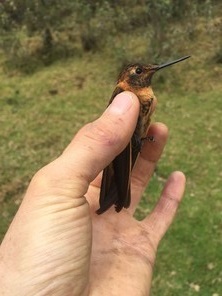
Shining Sunbeam (Aglaeactis cupripennis)
Figure 7b.

Collared Inca (Coeligena torquata)
Representative hummingbirds captured near Pantiacolla (Manú Province, Madre de Dios Region, 400 m).
Figure 8a.
Blue-fronted Lancebill (Doryfera johannae)
Figure 8b.
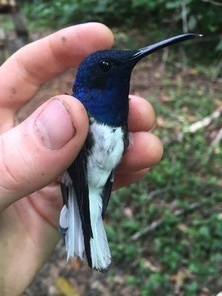
White-necked Jacobin (Florisuga mellivora)
Table 3.
Basic bill morphometrics from birds mist-netted along the Manú Gradient.
| Species | Sex (F=Female, M=Male, U=Unknown) |
Mean bill length (mm) | Bill length std dev (mm) | Mean bill width (mm) | Bill width std dev (mm) | Bill length sample size | Bill width sample size |
| Adelomyia melanogenys | F | 14.55 | 1.34 | 2.7 | 0 | 2 | 2 |
| Adelomyia melanogenys | U | 14.56 | 1.10 | 2.44 | 0.18 | 9 | 9 |
| Aglaeactis cupripennis | U | 18.06 | 1.05 | 2.64 | 0.11 | 5 | 5 |
| Boissonneaua matthewsii Bourcier | U | 18.4 | NA | 2.9 | NA | 1 | 1 |
| Chalcostigma ruficeps Gould | F | 11.5 | NA | 2 | NA | 1 | 1 |
| Chalcostigma ruficeps | M | 11.9 | 1.27 | 2.2 | 0.14 | 2 | 2 |
| Chlorostilbon mellisugus Linnaeus | F | 20.5 | NA | 2.7 | NA | 1 | 1 |
| Coeligena coeligena Lesson | U | 29.47 | 3.30 | 2.65 | 0.21 | 9 | 10 |
| Coeligena torquata Boissonneau | M | 32.4 | 1.9 | 2.66 | 0.20 | 3 | 3 |
| Coeligena torquata | F | 36.2 | NA | 3 | NA | 1 | 1 |
| Coeligena violifer Gould | U | 31.74 | 4.78 | 3.22 | 0.25 | 5 | 5 |
| Coeligena violifer | M | 33.13 | 0.98 | 3.26 | 0.25 | 3 | 3 |
| Coeligena violifer | F | 35.5 | 1.4 | 3.3 | 0.35 | 4 | 4 |
| Colibri coruscans Gould | U | 24.05 | 2.89 | 3.06 | 0.15 | 2 | 3 |
| Colibri thalassinus | U | 21.46 | 1.72 | 3 | 0.17 | 3 | 3 |
| Doryfera johannae Bourcier | F | 26.2 | NA | 3 | NA | 1 | 1 |
| Doryfera ludovicae | U | 27.62 | 7.90 | 2.75 | 0.14 | 7 | 8 |
| Doryfera ludovicae | M | 30.8 | NA | 2.6 | NA | 1 | 1 |
| Doryfera ludovicae | F | 31.2 | 1 | 2.5 | 0.26 | 3 | 3 |
| Eutoxeres condamini Bourcier | U | 24.23 | 1.52 | 3.87 | 0.68 | 8 | 7 |
| Florisuga mellivora Linnaeus | F | 18.1 | NA | 2.6 | NA | 1 | 1 |
| Florisuga mellivora | M | 18.7 | 0.28 | 3.45 | 0.49 | 2 | 2 |
| Glaucis hirsutus | M | 28.9 | NA | 3.3 | NA | 1 | 1 |
| Glaucis hirsutus | U | 29.15 | 1.21 | 3.82 | 0.29 | 4 | 4 |
| Heliangelus amethysticollis d'Orbigny & Lafresnaye | M | 17.46 | 0.69 | 2.46 | 0.29 | 6 | 6 |
| Heliangelus amethysticollis | U | 18.5 | NA | 2.5 | NA | 1 | 1 |
| Heliangelus amethysticollis | F | 18.65 | 0.21 | 2.8 | 0.14 | 2 | 2 |
| Heliodoxa leadbeateri | M | 20.56 | 0.99 | 2.95 | 0.05 | 6 | 6 |
| Heliodoxa leadbeateri | U | 20.8 | NA | 3.2 | NA | 1 | 1 |
| Heliodoxa leadbeateri | F | 22.27 | 0.82 | 3.2 | 0.16 | 4 | 4 |
| Ocreatus underwoodii Lesson | F | 15.6 | NA | 2.5 | NA | 1 | 1 |
| Ocreatus underwoodii | M | 15.8 | NA | 2.2 | 0.84 | 1 | 2 |
| Ocreatus underwoodii | U | 15.8 | NA | NA | NA | 1 | 0 |
| Phaethornis guy Lesson | F | 38.05 | 1.90 | 3.3 | 0.42 | 2 | 2 |
| Phaethornis guy | U | 39.6 | NA | 3 | NA | 1 | 1 |
| Phaethornis koepckeae Weske & Terborgh | U | 34.5 | 2.09 | 3.725 | 0.17 | 4 | 4 |
| Phaethornis superciliosus Linnaeus | U | 35.43 | 2.19 | 3.65 | 0.58 | 6 | 6 |
| Thalurania furcata Gmelin | F | 20.7 | 0.55 | 3.2 | 0.45 | 3 | 3 |
| Thalurania furcata | M | 23.65 | 4.03 | 3.55 | 0.49 | 2 | 2 |
| Thalurania furcata | U | 24.6 | 6.22 | 3.25 | 0.21 | 2 | 2 |
| Threnetes leucurus | U | 28.52 | 0.99 | 3.675 | 0.22 | 4 | 4 |
Diversity of plants exhibiting the bird pollination syndrome does not differ across the gradient in the time frame sampled (Table 4).
Table 4.
Site information for putatively bird pollinated plants along the Manú Gradient
| Collection numbers | Site | Latitude | Longitude | Altitude (m a.s.l.) | Date |
| MMAB 1 | San Pedro | -13.056864 | -71.546146 | 1347 | 4-ix-2016 |
| MMAB 2, 3 | San Pedro | -13.057179 | -71.546566 | 1402 | 4-ix-2016 |
| MMAB 6, 7 | San Pedro | -13.057697 | -71.547385 | 1393 | 4-ix-2016 |
| MMAB 8, 9 | San Pedro | -13.057311 | -71.547086 | 1411 | 4-ix-2016 |
| MMAB 10, 11 | San Pedro | -13.058199 | -71.547978 | 1403 | 4-ix-2016 |
| MMAB 12, 13 | San Pedro | -13.057907 | -71.548086 | 1357 | 4-ix-2016 |
| MMAB 20, 21 | San Pedro | -13.054945 | -71.545872 | 1378 | 6-ix-2016 |
| MMAB 22, 23 | San Pedro | -13.056268 | -71.546039 | 1394 | 6-ix-2016 |
| MMAB 24, 44 | San Pedro | -13.05637 | -71.54609 | 1355 | 7-ix-2016 |
| MMAB 25, 26 | San Pedro | -13.058848 | -71.547884 | 1330 | 7-ix-2016 |
| MMAB 27, 28 | San Pedro | -13.059836 | -71.54739 | 1360 | 7-ix-2016 |
| MMAB 29, 30 | San Pedro | -13.058044 | -71.549996 | 1269 | 8-ix-2016 |
| MMAB 33 | San Pedro | -13.05773 | -71.548458 | 1439 | 8-ix-2016 |
| MMAB 34, 35 | San Pedro | -13.057514 | -71.543293 | 1324 | 8-ix-2016 |
| MMAB 36, 37 | San Pedro | -13.05634 | -71.541812 | 1547 | 9-ix-2016 |
| MMAB 40, 39 | San Pedro | -13.054006 | -71.539007 | 1297 | 9-ix-2016 |
| MMAB 43, 38 | San Pedro | -13.058459 | -71.548074 | 1363 | 10-ix-2016 |
| MMAB 42, 41 | San Pedro | -13.058199 | -71.547978 | 1403 | 11-ix-2016 |
| MMAB 45 | San Pedro | -13.191861 | -71.588599 | 1149 | 16-ix-2016 |
| MMAB 49, 48 | Wayqecha | -13.173428 | -71.587187 | 2727 | 20-ix-2016 |
| MMAB 50, 51 | Wayqecha | -13.17706 | -71.586071 | 2939 | 21-ix-2016 |
| MMAB 52, 53 | Wayqecha | -13.179536 | -71.585172 | 2958 | 21-ix-2016 |
| MMAB 54, 55 | Wayqecha | -13.180133 | -71.585235 | 2955 | 22-ix-2016 |
| MMAB 56, 57 | Wayqecha | -13.174448 | -71.587465 | 2888 | 26-ix-2016 |
| MMAB 58, 59 | Wayqecha | -13.176716 | -71.581308 | 2625 | 26-ix-2016 |
| MMAB 60, 61 | Wayqecha | -13.174771 | -71.588345 | 2866 | 27-ix-2016 |
| MMAB 63, 62 | Wayqecha | -13.174751 | -71.588335 | 2904 | 27-ix-2016 |
| MMAB 64, 65 | Wayqecha | -13.191716 | -71.586709 | 2834 | 28-ix-2016 |
| MMAB 66, 67 | Wayqecha | -13.18732 | -71.585754 | 2979 | 28-ix-2016 |
| MMAB 68, 69 | Wayqecha | -13.173166 | -71.591911 | 2780 | 29-ix-2016 |
| MMAB 70, 71 | Pantiacolla | -12.656352 | -71.230691 | 398 | 6-x-2016 |
| MMAB 72 | Pantiacolla | -12.655418 | -71.229373 | 391 | 7-x-2016 |
| MMAB 75, 74 | Pantiacolla | -12.656351 | -71.230732 | 396 | 8-x-2016 |
| MMAB 76, 77 | Pantiacolla | -12.64719 | -71.240662 | 394 | 8-x-2016 |
| MMAB 78, 79 | Pantiacolla | -12.645874 | -71.234135 | 410 | 9-x-2016 |
| MMAB 80, 81 | Pantiacolla | -12.65622 | -71.231045 | 404 | 9-x-2016 |
| MMAB 82, 83 | Pantiacolla | -12.656216 | -71.230678 | 404 | 9-x-2016 |
| MMAB 84, 85 | Pantiacolla | -12.656545 | -71.231864 | 405 | 11-x-2016 |
| MMAB 86, 87 | Pantiacolla | -12.656431 | -71.231836 | 396 | 11-x-2016 |
| MMAB 88, 89 | Pantiacolla | -12.650034 | -71.225302 | 428 | 12-x-2016 |
| MMAB 90, 91 | Pantiacolla | -12.651347 | -71.22389 | 391 | 12-x-2016 |
| MMAB 93, 92 | Pantiacolla | -12.65138 | -71.223853 | 397 | 12-x-2016 |
| MMAB 94, 95 | Pantiacolla | -12.651421 | -71.223706 | 423 | 13-x-2016 |
| MMAB 96, 97 | Pantiacolla | -12.651113 | -71.223842 | 394 | 13-x-2016 |
Discussion
Hummingbird pollination is common and well-established in Neotropical montane and lowland environments. Our observations and collected specimens exemplify that bird-plant interactions are readily observed along the Manú Gradient - an area that is relatively accessible has been subject to only a handful of studies on hummingbird pollination (Oreocallis grandiflora, Proteaceae; Hazlehurst et al. 2016, Hazlehurst and Karubian 2016).
Along the gradient, putatively bird pollinated plants were generally characterized by long corollas and were predominantly coloured red, yellow, orange, or some combination thereof. Previous documentation of bird pollination exists for each of the 16 families collected (Cronk and Ojeda 2008, Johnson and Nicolson 2008), but undocumented species-level bird pollination systems may arise from focusing on lesser-stuided taxa (e.g. Thyrsacanthus, Pentagonia, Pachystachys). Many putatively bird pollinated plants contained too little nectar to effectively measure sugar concentration at the time of sampling. We suspect that early morning visitations by nectarivorous birds and insects (i.e., both pollinators and nectar robbers) influenced this outcome. Indeed, in some cases inspection of certain plants revealed that the flower had been recently robbed as indicated by punctures at the base of the corolla. In as little as bird pollination has been studied along the Manú Gradient, even less is known of the ecological and evolutionary dynamics of nectary robbery. As this survey was preliminary, time did not allow for multi-day sampling at one locale to isolate nectar. A focus on a specific plant taxon would allow familiarity for nectar phenology and hence, more effective collection of nectar.
We recorded 23 independent visits by hummingbirds to 19 different plant taxa over 33 days. These observations by no means represent a comprehensive list of the total diversity for hummingbirds (Walker et al. 2006), bird-pollinated plants, or the interactions between these two groups. An estimate of total diversity will come only with an extended sampling effort at each site. Relatively few hummingbirds were captured or observed in the lowlands (Table 3) compared to the other two sites. It is likely that this resulted from differences in foraging behavior between hummingbird species, rather than local abundance. For example, in the lowlands, a higher proportion of hummingbirds (e.g. Phaethornis) exhibit traplining behaviour (i.e. repeated visits along a route of flowering locations) compared to territorial guarding of floral resources. In addition, because of the higher canopy, many of the trees, lianas, and epiphytes inhabit canopy heights that are logistically difficult to sample.
The number of plants exhibiting bird pollination syndrome and number of bird visits observed are comparable between sites. That is, at a coarse scale we did not find any indication that elevation affects the absolute diversity of bird pollinated plant taxa (as expected by Cruden 1972), although the Manú Gradient would be an ideal location to test the hypothesis that bird and insect pollinated plants occupy distinct ecological niches. Between species, corolla length and width encompasses a great amount of variation, but hummingbird bill morphology varies less Tables 1, 3. This may speak to the adaptability of flowers relative to bills. It may be that because flowers serve a singular purpose (attraction and exclusion of pollinators and robbers, respectively), whereas bills have many uses (feeding, aggression, preening, balance), that bill evolution is relatively constrained. Bill morphology data will be used to inform phylogenetic tests of bill-flower shape evolution in future studies.
Evaluating the extent to which plants and their pollinators contribute to maintaining local biodiversity, and identifying keystone species within these systems (Ebenman and Jonsson 2005) will be important to maintaining ecological and cultural heritage in the Manú region (Ministerio del Ambiente (Ministry of Environment) 2017). This study provides a baseline for future work in pollination ecology along the Manú Gradient. Any one of the 44 plant species highlighted here warrants closer investigation, and we anticipate that further studies will help clarify the roles of hummingbirds as pollinators for the plant taxa described herein..
Acknowledgements
The authors would like to acknowledge Daniela Olivera (Universidad Nacional de San Antonio Abad del Cusco) for their assistance in the field, as well as the staff of Wayqecha Biological Station, Cock-of-the-Rock Lodge, and Pantiacolla Lodge. We also acknowledge Jenny Muñoz (University of British Columbia), the Asociación para la Conservación de la Cuenca Amazónica (ACCA), and the Servicio Nacional Forestal y de Fauna Silvestre (SERFOR) for assistance in administering research permits, and Prof. Carlos Reynel and the herbarium staff at Universidad Nacional Agraria La Molina for generously providing assistance at all stages of this project. Identification of our Geseneriacae specimens were greatly improved by Dr. John Clark (University of Alabama). Identification of numerous other specimens were assisted by Dr. Quentin Cronk (University of British Columbia). This expedition was supported by grants from the Natural Sciences and Engineering Research Council of Canada (NSERC) Discovery Grants Program, held by Dr. Quentin Cronk (RGPIN-2014-05820) and Dr. Jill Jankowski (RGPIN-2012-418294), as well as a Walter H. Lewis Award in Plant Biodiversity to MMA Boehm and a Werner and Hildegard Hesse Research Award to MN Scholer.
References
- Bridson D., Forman L. The Herbarium Handbook. Royal Botanic Gardens, Kew; London: 2000. 65-89 [Google Scholar]
- Cronk Q., Ojeda I. Bird-pollinated flowers in an evolutionary and molecular context. http://dx.doi.org/10.1093/jxb/ern009. Journal of Experimental Botany. 2008;59(4):715–727. doi: 10.1093/jxb/ern009. [DOI] [PubMed] [Google Scholar]
- Cruden R. W. Pollinators in high-hlevation ecosystems: relative effectiveness of birds and bees. http://dx.doi.org/10.1126/science.176.4042.1439. Science. 1972;176(4042):1439–1440. doi: 10.1126/science.176.4042.1439. [DOI] [PubMed] [Google Scholar]
- Dehling D. Matthias, Fritz Susanne A., Töpfer Till, Päckert Martin, Estler Patrizia, Böhning-Gaese Katrin, Schleuning Matthias. Functional and phylogenetic diversity and assemblage structure of frugivorous birds along an elevational gradient in the tropical Andes. http://dx.doi.org/10.1111/ecog.00623. Ecography. 2014 doi: 10.1111/ecog.00623. [DOI]
- Ebenman Bo, Jonsson Tomas. Using community viability analysis to identify fragile systems and keystone species. http://dx.doi.org/10.1016/j.tree.2005.06.011. Trends in Ecology & Evolution. 2005;20(10):568–575. doi: 10.1016/j.tree.2005.06.011. [DOI] [PubMed] [Google Scholar]
- Fenster C. B., Armbruster W. S., Wilson P., Dudash M. R., Thomson J. D. Pollination syndromes and floral specialization. Annual Review of Ecology, Evolution, and Systematics. 2004;35:375–403. doi: 10.1146/annurev.ecolsys.34.011802.132347. [DOI] [Google Scholar]
- Girardin C. A.J., Malhi Y., Aragão L. E.O.C., Mamani M., Huaraca Huasco W., Durand L., Feeley K. J., Rapp J., Silva-Espejo J. E., Silman M., Salinas N., Whittaker R. J. Net primary productivity allocation and cycling of carbon along a tropical forest elevational transect in the Peruvian Andes. Global Change Biology. 2010;16(12):3176–3192. doi: 10.1111/j.1365-2486.2010.02235.x. [DOI] [Google Scholar]
- Hazlehurst Jenny A., Karubian Jordan O. Nectar robbing impacts pollinator behavior but not plant reproduction. http://dx.doi.org/10.1111/oik.03195. Oikos. 2016;125(11):1668–1676. doi: 10.1111/oik.03195. [DOI] [Google Scholar]
- Hazlehurst JA, Tinoco B, Cárdenas S, Karubian J. Pollination ecology of Oreocallis grandiflora (Proteaceae) at the northern and southern ends of its geographic range. Journal of Pollination Ecology. 2016;19(10):71–80. [Google Scholar]
- Hillyer Rachel, Silman Miles R. Changes in species interactions across a 2.5 km elevation gradient: effects on plant migration in response to climate change. http://dx.doi.org/10.1111/j.1365-2486.2010.02268.x. Global Change Biology. 2010;16(12):3205–3214. doi: 10.1111/j.1365-2486.2010.02268.x. [DOI] [Google Scholar]
- Jankowski Jill E., Londoño Gustavo A., Robinson Scott K., Chappell Mark A. Exploring the role of physiology and biotic interactions in determining elevational ranges of tropical animals. http://dx.doi.org/10.1111/j.1600-0587.2012.07785.x. Ecography. 2012;36(1):1–12. doi: 10.1111/j.1600-0587.2012.07785.x. [DOI] [Google Scholar]
- Jankowski Jill E., Merkord Christopher L., Rios William Farfan, Cabrera Karina García, Revilla Norma Salinas, Silman Miles R. The relationship of tropical bird communities to tree species composition and vegetation structure along an Andean elevational gradient. http://dx.doi.org/10.1111/jbi.12041. Journal of Biogeography. 2012;40(5):950–962. doi: 10.1111/jbi.12041. [DOI] [Google Scholar]
- Johnson Steven D, Nicolson Susan W. Evolutionary associations between nectar properties and specificity in bird pollination systems. http://dx.doi.org/10.1098/rsbl.2007.0496. Biology Letters. 2008;4(1):49–52. doi: 10.1098/rsbl.2007.0496. [DOI] [PMC free article] [PubMed] [Google Scholar]
- Londoño Gustavo A., Chappell Mark A., Castañeda María del Rosario, Jankowski Jill E., Robinson Scott K. Basal metabolism in tropical birds: latitude, altitude, and the “pace of life”. Functional Ecology. 2014;29:338–346. doi: 10.1111/1365-2435.12348. [DOI] [Google Scholar]
- Londoño Gustavo A., Chappell Mark A., Jankowski Jill E., Robinson Scott K. Do thermoregulatory costs limit altitude distributions of Andean forest birds? Functional Ecology. 2016;31:204–215. doi: 10.1111/1365-2435.12697. [DOI] [Google Scholar]
- Malhi Y., Silman M., Salinas N., Bush M., Meir P., Saatchi S. Introduction: Elevation gradients in the tropics: laboratories for ecosystem ecology and global change research. http://dx.doi.org/10.1111/j.1365-2486.2010.02323.x. Global Change Biology. 2010;16(12):3171–3175. doi: 10.1111/j.1365-2486.2010.02323.x. [DOI] [Google Scholar]
- Malhi Yadvinder, Girardin Cécile A J, Goldsmith Gregory R, Doughty Christopher E, Salinas Norma, Metcalfe Daniel B, Huaraca Huasco Walter, Silva-Espejo Javier E, Del Aguilla-Pasquell Jhon, Farfán Amézquita Filio, Aragão Luiz E O C, Guerrieri Rossella, Ishida Françoise Yoko, Bahar Nur H A, Farfan-Rios William, Phillips Oliver L, Meir Patrick, Silman Miles. The variation of productivity and its allocation along a tropical elevation gradient: a whole carbon budget perspective. http://dx.doi.org/10.1111/nph.14189. The New Phytologist. 2016;214(3):1019–1032. doi: 10.1111/nph.14189. [DOI] [PubMed] [Google Scholar]
- Merkord C. L. Seasonality and elevational migration in an Andean bird community. Doctoral Dissertation. University of Missouri.; 2010. [Google Scholar]
- Environment) Ministerio del Ambiente (Ministry of. Establece el parque nacional del manu en los Departamentos de Madre de Dios y Cuzco (promulgado el 29 de mayo de 1973). http://legislacionanp.org.pe/parque-nacional-del-manu/ Decreto Supremo nº 0644-73-ag (1) 2017 Spanish.
- Munoz Jenny. The role of facilitation in the structure of tropical bird communities : a case study of mixed-species flocks. http://dx.doi.org/10.14288/1.0303480. Doctoral Dissertation. University of British Columbia. 2016 doi: 10.14288/1.0303480. [DOI]
- Myers Norman, Mittermeier Russell A., Mittermeier Cristina G., da Fonseca Gustavo A. B., Kent Jennifer. Biodiversity hotspots for conservation priorities. http://dx.doi.org/10.1038/35002501. Nature. 2000;403(6772):853–858. doi: 10.1038/35002501. [DOI] [PubMed] [Google Scholar]
- Ollerton Jeff, Alarcón Ruben, Waser Nickolas M, Price Mary V, Watts Stella, Cranmer Louise, Hingston Andrew, Peter Craig I, Rotenberry John. A global test of the pollination syndrome hypothesis. http://dx.doi.org/10.1093/aob/mcp031. Annals of Botany. 2009;103(9):1471–1480. doi: 10.1093/aob/mcp031. [DOI] [PMC free article] [PubMed] [Google Scholar]
- Rapp JM, Silman MR. Diurnal, seasonal, and altitudinal trends in microclimate across a tropical montane cloud forest. http://dx.doi.org/10.3354/cr01127. Climate Research. 2012;55(1):17–32. doi: 10.3354/cr01127. [DOI] [Google Scholar]
- Stiles F. G. Ecological and evolutionary implications of bird pollination. American Zoologist. 1978;18(4):715–727. doi: 10.1093/icb/18.4.715. [DOI] [Google Scholar]
- Walker B, Stotz D. F., Pequeño T., Fitzpatrick J. W. Birds of the Manu Biosphere Reserve. Fieldiana Zoology. 2006;110:23–49. [Google Scholar]
- Weng Chengyu, Bush Mark B., Silman Miles R. An analysis of modern pollen rain on an elevational gradient in southern Peru. Journal of Tropical Ecology. 2004;20(1):113–124. doi: 10.1017/s0266467403001068. [DOI] [Google Scholar]




